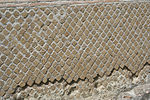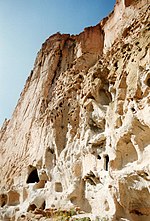Roman concrete (redirect from Opus caementicium)
Roman concrete, also called opus caementicium, was used in construction in ancient Rome. Like its modern equivalent, Roman concrete was based on a hydraulic-setting...
19 KB (2,032 words) - 07:25, 5 October 2024
Reticulate work developed in response to the advent of opus caementicium and its predecessor, opus incertum.: 136–45 This was to accommodate both the new...
20 KB (2,279 words) - 07:00, 23 May 2024
technique in which course-laid brickwork is used to face a core of opus caementicium. Opus reticulatum was the dominant form of wall construction in the Imperial...
2 KB (151 words) - 21:48, 31 December 2023
Opus signinum ('cocciopesto' in modern Italian) is a building material used in ancient Rome. It is a form of Roman concrete (opus caementicium), the main...
5 KB (664 words) - 22:10, 10 July 2024
placed uncut stones or fist-sized tuff blocks inserted in a core of opus caementicium. Initially it consisted of more careful placement of the caementa...
2 KB (182 words) - 21:48, 31 December 2023
Opus caementicium – Building material used in ancient Rome Opus incertum – Ancient Roman masonry using irregular stones in a core of concrete Opus quadratum –...
2 KB (142 words) - 21:48, 31 December 2023
toward monumental architecture, was the invention of Roman concrete (opus caementicium), which led to the liberation of shapes from the dictates of the traditional...
100 KB (12,310 words) - 18:00, 6 October 2024
setting. The word "cement" can be traced back to the Ancient Roman term opus caementicium, used to describe masonry resembling modern concrete that was made...
81 KB (9,432 words) - 16:00, 7 October 2024
from 300 BC to AD 476. During the Roman Empire, Roman concrete (or opus caementicium) was made from quicklime, pozzolana and an aggregate of pumice. Its...
122 KB (14,134 words) - 05:17, 11 October 2024
of opus caementicium. Opus latericium Ancient Roman form of construction in which coarse-laid brickwork is used to face a core of opus caementicium. Opus...
41 KB (5,073 words) - 10:55, 30 August 2024
slabs and built with various techniques of rigging: opus vittatum, opus africanum and opus caementicium or Roman concrete. The forum of Tiberius housed,...
55 KB (7,323 words) - 02:28, 11 October 2024
villas which included the fishponds, private harbours and docks in opus caementicium. Nevertheless a rich resource of inscriptions documenting the population...
9 KB (1,185 words) - 08:37, 27 August 2024
from the original on February 14, 2014. Retrieved 31 December 2014. Opus caementicium roman walls Wikimedia Commons has media related to Opus spicatum....
4 KB (395 words) - 09:42, 19 March 2024
Roman masonry in diamond-shaped bricks of tuff, covering a core of opus caementicium G.R.H. Wright (23 November 2009). Ancient Building Technology, Volume...
3 KB (414 words) - 10:20, 8 April 2024
Romans made extensive use of rubble masonry, calling it opus caementicium, because caementicium was the name given to the filling between the two revetments...
3 KB (394 words) - 06:14, 17 September 2024
opus quadratum – Roman masonry using parallel courses of squared stone of the same height Pietra dura Roman concrete, also known as opus caementicium –...
8 KB (997 words) - 07:07, 5 October 2024
Maria Laura Santarelli. 2006. "Mechanical characteristics of Roman 'opus caementicium'". Fracture and Failure of Natural Building Stones. Applications in...
42 KB (4,848 words) - 16:53, 17 September 2024
I-beam – steel lintels and beams Marriage stone – decorative lintel Opus caementicium Structural design Timber framing – post and beam systems Stonehenge...
7 KB (748 words) - 19:45, 12 September 2024
exedras open, whose base uses the same construction technique, the opus caementicium. On the western limit, and in an axial position, there is a rectangular...
66 KB (9,314 words) - 22:02, 16 October 2024
Africa, but also found in Sicily and Southern Italy. Roman concrete (opus caementicium) – building material used in construction during the late Roman Republic...
1 KB (106 words) - 21:48, 31 December 2023
is uncertain – some scholars place it on the rectangular podium in opus caementicium with basalt chips discovered in the 19th century during the construction...
2 KB (124 words) - 00:19, 14 July 2024
corresponding to 40 or 42 Roman feet. Tuff (inner parts of the building) Opus caementicium (inner parts of the building) Travertine (walls of the podium and...
32 KB (4,183 words) - 11:02, 13 October 2024
inlets are still visible inside the rooms. The cisterns are made of Opus caementicium which is the waterproofing old Roman concrete. The level of the water...
12 KB (1,459 words) - 15:11, 5 October 2024
monumental architecture was the invention of Roman concrete (also called opus caementicium), which led to the liberation of the shape from the dictate of the...
12 KB (1,242 words) - 23:36, 4 March 2024
walls of the military buildings were built on mortared plinths called opus caementicium, with wooden and daub walls faced with keyed plaster. Roman military...
89 KB (10,494 words) - 23:43, 10 October 2024
stone of the same height Opus reticulatum – Roman masonry in diamond-shaped bricks of tuff, covering a core of opus caementicium Roman concrete – Building...
1 KB (131 words) - 21:48, 31 December 2023
the only ones to construct bridges with concrete, which they called Opus caementicium. The outside was usually covered with brick or ashlar, as in the Alcántara...
27 KB (2,985 words) - 01:09, 15 September 2024
of the land, this building was constructed on flat ground using 'opus caementicium'. It was modeled after the Theatre of Marcellus in Rome, featuring...
9 KB (842 words) - 10:05, 24 September 2024
allowing the mortar to dry or the influence of inclement weather. The opus caementicium filling was completed initially, followed by the facings, which were...
140 KB (13,707 words) - 16:38, 28 September 2024
tecta, lower portico and upper portico respectively and were built in opus caementicium. The special feature is the sophisticated structure of the vaults...
23 KB (3,211 words) - 19:53, 6 September 2024



























